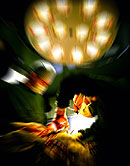
WEDNESDAY, Dec. 29 (HealthDay News) — Doctors can learn more about anesthesia, sleep and coma by paying attention to what the three have in common, a new report suggests.
“This is an effort to try to create a common discussion across the fields,” said review co-author Dr. Emery N. Brown, an anesthesiologist at Massachusetts General Hospital. “There is a relationship between sleep and anesthesia: could this help us understand ways to produce new sleeping medications? If we understand how people come out of anesthesia, can it help us help people come out of comas?”
The researchers, who compared the physical signs and brain patterns of those under anesthesia and those who were asleep, report their findings in the Dec. 30 issue of the New England Journal of Medicine. They acknowledged that anesthesia, sleep and coma are very different states in many ways and, in fact, only the deepest stages of sleep resemble the lightest stages of anesthesia. And people choose to sleep, for example, but lapse into comas involuntarily. But, as Brown puts it, general anesthesia is “a reversible drug-induced coma,” even though physicians prefer to tell patients that they’re “going to sleep.”
“They say ‘sleep’ because they don’t want to scare patients by using the word ‘coma,'” Brown said. But even anesthesiologists use the term without understanding that it’s not quite accurate, he said. “On one level, we truly don’t have it clear in our minds from a neurological standpoint what we’re doing.”
So what do sleep and anesthesia have in common? Physicians monitor the brains of people when they’ve been knocked out by anesthesia, and they do the same thing when they study people who are sleeping, Brown said. “If you have a better understanding of how brain circuits work, you can better understand how to do this.”
Another study co-author said both sleep and anesthesia can help shed light on coma, a little understood phenomenon that strikes people with brain injury and can be induced by physicians to help the body heal.
Dr. Nicholas D. Schiff, a professor of neurology and neuroscience at Weill Cornell Medical College in New York City, said the framework laid by the report, which he co-authored, may help doctors gain better insight into how people recover from brain injuries because the process is similar to coming out of general anesthesia.
“We know very little about the step-by-step changes that are associated with recovery from coma,” Schiff said. “It’s clear that you can have recovery over long periods of time, but figuring out who will recover and why is less clear.”
Dr. Debra A. Schwinn, chairwoman of the department of anesthesiology & pain medicine at the University of Washington, said the new report is strong and “boldly suggests that anesthetic action in the human brain may be more in parallel with sleep and coma than originally envisioned.”
In the future, she said, new ideas about how sleep works — that it may be centered in compartments of the brain instead of the whole organ — “will be very interesting to pursue as they may relate to anesthesia action in the years to come.”
More information
For more about anesthesia, visit the U.S. National Library of Medicine.

